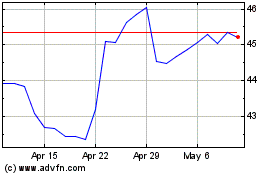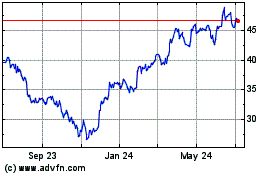GM Super-Cruise Feature Raises Concerns From Regulators -- Update
November 28 2016 - 4:41PM
Dow Jones News
By Mike Spector
U.S. highway safety regulators raised concerns over General
Motors Co.'s plan to halt semiautonomous vehicles with unresponsive
motorists, the latest push from government officials to police the
development of self-driving cars.
The National Highway Traffic Safety Administration urged the
Detroit auto maker to ensure safety for a forthcoming "Super
Cruise" system feature that will slowly bring vehicles to a stop
when motorists fail to retake control of the wheel, according to a
letter from the agency to GM disclosed on Monday.
"We note that GM indicates that when the driver is unable or
unwilling to take control of the vehicle the system will bring the
vehicle to a stop 'in or near the roadway,'" wrote NHTSA Chief
Counsel Paul Hemmersbaugh in the Nov. 18 letter to GM.
"We urge GM to fully consider the likely operation of the system
it is contemplating and ensure that this fallback solution does not
present an unreasonable risk to safety," Mr. Hemmersbaugh
wrote.
The letter included a footnote emphasizing that federal law
requires recalls for vehicles with safety defects that pose
unreasonable risks for accidents or deaths and injuries in
crashes.
A GM spokesman didn't immediately respond to a request for
comment. GM's system, previously set to debut on a Cadillac car
this year, has been delayed until 2017.
The NHTSA letter, which approved GM's automatic activation of
hazard lights in the slow-halt situation, furthered government
officials' push to ramp up oversight for self-driving cars that
aren't governed by current regulations. The Obama administration in
September released voluntary guidelines pressuring auto makers to
self-certify driverless cars through a 15-point safety assessment
outlining safeguards should systems fail and how the vehicles are
tested, among other details. Auto makers, while supporting
officials' efforts to avoid conflicting state rules for autonomous
cars, have called the guidelines too ambiguous.
Regulators also have encouraged auto makers to seek
interpretations of existing rules to confirm their technologies
aren't running afoul of legal requirements. GM did just that,
seeking confirmation from regulators that a plan to activate hazard
lights when Super Cruise brings cars to a halt complied with a
current federal safety standard.
Mr. Hemmersbaugh's letter confirmed GM's hazard-lights plan
passed regulatory muster. But the letter also expressed concerns
about bringing the vehicle to a stop in or near the roadway in the
first place.
GM's plan to sometimes slowly halt vehicles addresses a common
concern auto makers face when developing self-driving technology:
how to avoid complacency among motorists. Tesla Motors Inc. in
September unveiled an update to its semi-automated Autopilot system
that disables an auto-steering function when drivers ignore three
warnings to put hands back on the wheel in a one-hour span. The
feature can't be reactivated until the car is stopped and
restarted.
Tesla's update came several months after the Silicon Valley
company's technology failed to detect a tractor-trailer cutting in
front of one of its electric cars, resulting in a fatal crash.
Tesla Chief Executive Elon Musk said the features included in the
latest Autopilot update likely would have prevented that crash.
GM's Super Cruise, promoted with hands-free capability, won't be
introduced until next year. The auto maker has pointed to "getting
the technology right and doing it safely" without pinpointing
reasons for the delay.
Write to Mike Spector at mike.spector@wsj.com
(END) Dow Jones Newswires
November 28, 2016 16:26 ET (21:26 GMT)
Copyright (c) 2016 Dow Jones & Company, Inc.
General Motors (NYSE:GM)
Historical Stock Chart
From Mar 2024 to Apr 2024

General Motors (NYSE:GM)
Historical Stock Chart
From Apr 2023 to Apr 2024
